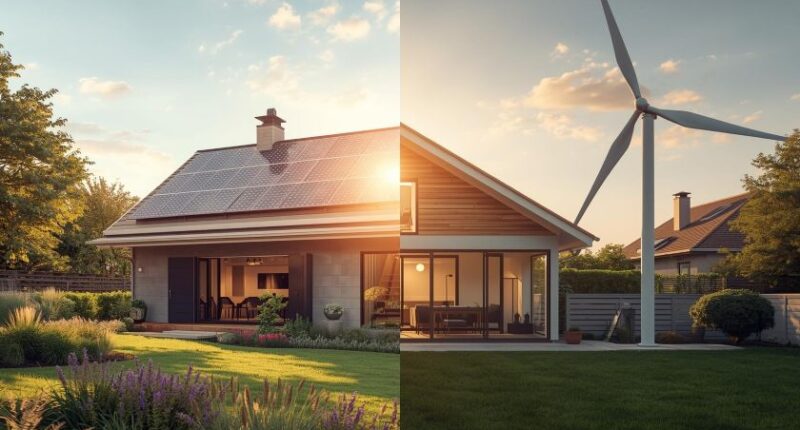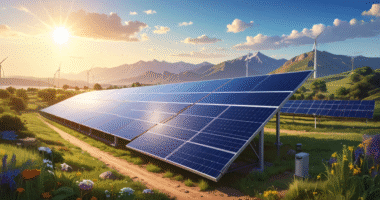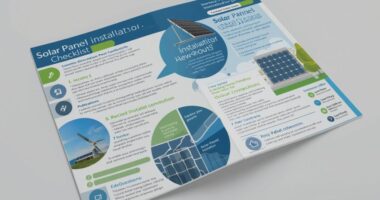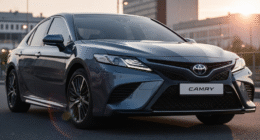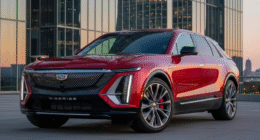As homeowners around the world search for ways to lower energy bills and reduce carbon footprints, two renewable energy options often take center stage: solar power and wind energy. Both promise clean, sustainable electricity — but which one is better for your home?
In this in-depth guide, we’ll compare solar vs. wind power across performance, cost, maintenance, and efficiency to help you decide which renewable solution best fits your needs.
Understanding the Basics of Solar and Wind Power
What Is Solar Power?
Solar energy harnesses sunlight through solar photovoltaic (PV) panels, which convert sunlight directly into electricity. The panels are typically installed on rooftops or in open areas with maximum sun exposure.
Solar systems can be connected to the grid or operate off-grid with battery storage. As technology advances, modern panels are more efficient, durable, and affordable than ever before.
What Is Wind Energy?
Wind energy uses turbines to convert wind movement into electricity. As wind spins the turbine blades, the motion generates kinetic energy, which is transformed into electrical power through a generator.
While wind power is often associated with large wind farms, residential wind turbines are now becoming more common for homeowners with enough land and steady wind speeds.
Comparing Solar Power vs. Wind Energy
To determine which renewable energy option is better for your home, let’s look at key factors that affect efficiency, practicality, and cost.
1. Power Output and Efficiency
Solar Power Efficiency
Modern solar panels typically have efficiency rates between 18% and 23%. Their output depends on sunlight exposure, roof angle, shading, and geographic location. Homes in sunny areas like California, Arizona, or Australia can maximize energy production year-round.
Wind Energy Efficiency
Residential wind turbines can convert about 35%–45% of wind energy into electricity, making them more efficient than solar panels — but only in the right conditions.
Wind speed plays a critical role: most turbines require an average wind speed of at least 10–12 mph (16–19 km/h) to generate power efficiently.
✅ Verdict:
-
Solar performs better in areas with abundant sunlight and less open land.
-
Wind wins in regions with steady, high wind speeds.
2. Installation Requirements
Solar Power Installation
Solar panels can be mounted on rooftops or ground arrays. Installation typically requires:
-
South-facing exposure (in the Northern Hemisphere)
-
Unobstructed sunlight
-
A roof strong enough to support the panels
Solar installation is relatively easy and can be completed within 1–3 days.
Wind Energy Installation
Residential wind turbines require more space and specific site conditions. You’ll need:
-
At least one acre of open land
-
Minimal obstructions (trees, buildings, hills)
-
Proper permits and zoning approvals
Installation can be more complex due to tower construction, wiring, and safety compliance.
✅ Verdict:
-
Solar is easier to install for most homes.
-
Wind suits rural or coastal properties with wide-open spaces.
3. Cost Comparison
Solar Power Costs
The average cost of a residential solar system in 2025 is around $2.30–$3.00 per watt. For a 6 kW system, that’s about $13,000–$18,000 before incentives.
Federal tax credits and local rebates can reduce upfront costs by 25%–35%, and systems typically pay for themselves in 6–8 years through energy savings.
Wind Energy Costs
A small home wind turbine system can range from $10,000 to $70,000, depending on size and capacity. For example:
-
1–2 kW system (for partial home use): $10,000–$15,000
-
5–10 kW system (whole-home use): $40,000–$70,000
However, wind turbines often require higher maintenance costs over time due to moving parts.
✅ Verdict:
-
Solar is more affordable for most homeowners, especially with rebates.
-
Wind is costlier upfront and better suited for large properties.
4. Maintenance and Durability
Solar Maintenance
Solar panels have no moving parts, making maintenance simple. Occasional cleaning and inverter checks are usually enough. Panels typically last 25–30 years with minimal degradation.
Wind Maintenance
Wind turbines have many mechanical parts — blades, bearings, and gearboxes — which require regular inspection and maintenance. Wind systems generally last 20–25 years, but maintenance costs can add up.
✅ Verdict:
-
Solar wins for lower maintenance and longer lifespan.
-
Wind requires more upkeep but can produce power continuously.
5. Energy Reliability and Storage
Solar Energy Reliability
Solar panels only generate power during daylight, so battery storage (like Tesla Powerwall or similar systems) helps store excess energy for night use.
Wind Energy Reliability
Wind can generate electricity both day and night — as long as wind speeds are consistent. However, wind is unpredictable and can drop suddenly.
✅ Verdict:
-
Solar + Battery systems provide steady, predictable power.
-
Wind can outperform solar in windy, off-grid locations.
6. Environmental Impact
Both solar and wind are eco-friendly alternatives to fossil fuels, but they have different environmental considerations.
-
Solar: Manufacturing panels involves mining materials like silicon and lithium, but emissions are minimal over their lifetime.
-
Wind: Turbines are clean in operation but can impact local bird populations and require large land areas.
✅ Verdict:
Both are sustainable, but solar has a smaller ecological footprint for home installations.
Solar vs. Wind: Which Is Better for You?
Choosing between solar and wind depends on where you live and your energy needs.
| Factor | Solar Power | Wind Energy |
|---|---|---|
| Ideal Location | Sunny regions | Windy, open areas |
| Space Required | Rooftop or small yard | Large open land |
| Cost | Lower upfront | Higher upfront |
| Maintenance | Low | Moderate to high |
| Energy Output | Consistent during day | Variable, 24/7 potential |
| Installation Difficulty | Easy | Complex |
| Environmental Impact | Low | Moderate |
✅ Best for Urban Homes: Solar Power
✅ Best for Rural or Coastal Properties: Wind Energy
✅ Best Hybrid Solution: Combine both for consistent, all-weather power generation
Hybrid Systems: The Best of Both Worlds
Many modern eco-homes are adopting hybrid renewable systems, combining solar panels and small wind turbines.
This setup ensures:
-
Power generation day and night
-
Backup during cloudy or windless days
-
Maximum energy independence
Hybrid systems also make it easier to go off-grid completely while maintaining reliable electricity supply throughout the year.
Conclusion
When it comes to deciding between solar power and wind energy for your home, there’s no one-size-fits-all answer.
-
If you live in a sunny suburban or urban area, solar power is the most efficient, affordable, and maintenance-free choice.
-
If you own rural or coastal property with steady wind, a home wind turbine can generate more consistent energy and complement solar panels perfectly.
Ultimately, the best renewable solution is the one that fits your location, energy usage, and long-term goals. Whether you harness the sun, the wind, or both — switching to clean energy is a powerful step toward a sustainable, cost-effective future.
